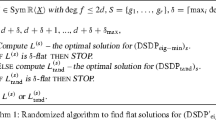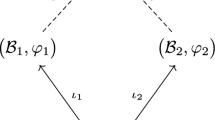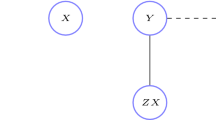Abstract
Motivated by recent progress in quantum information theory, this article aims at optimizing trace polynomials, i.e., polynomials in noncommuting variables and traces of their products. A novel Positivstellensatz certifying positivity of trace polynomials subject to trace constraints is presented, and a hierarchy of semidefinite relaxations converging monotonically to the optimum of a trace polynomial subject to tracial constraints is provided. This hierarchy can be seen as a tracial analog of the Pironio, Navascués and Acín scheme (Pironio et al. in New J. Phys. 10(7):073013, 2008) for optimization of noncommutative polynomials. The Gelfand–Naimark–Segal (GNS) construction is applied to extract optimizers of the trace optimization problem if flatness and extremality conditions are satisfied. These conditions are sufficient to obtain finite convergence of our hierarchy. The results obtained are applied to violations of polynomial Bell inequalities in quantum information theory. The main techniques used in this paper are inspired by real algebraic geometry, operator theory, and noncommutative algebra.
Similar content being viewed by others
References
Anjos, M.F., Lasserre, J.B. (eds.): Handbook on Semidefinite, Conic and Polynomial Optimization. International Series in Operations Research& Management Science, vol. 166. Springer, New York (2012)
Ayupov, S., Rakhimov, A., Usmanov, S.: Jordan, Real and Lie Structures in Operator Algebras. Mathematics and Its Applications, vol. 418. Kluwer Academic Publishers Group, Dordrecht (1997)
Barvinok, A.: A Course in Convexity. Graduate Studies in Mathematics, vol. 54. American Mathematical Society, Providence (2002)
Burgdorf, S., Cafuta, K., Klep, I., Povh, J.: The tracial moment problem and trace-optimization of polynomials. Math. Program. 137(1–2, Ser. A), 557–578 (2013)
Bardet, I., Collins, B., Sapra, G.: Characterization of equivariant maps and application to entanglement detection. Ann. Henri Poincaré 21(10), 3385–3406 (2020)
Bell, J.S.: On the Einstein Podolsky Rosen paradox. Phys. Phys. Fizika 1(3), 195 (1964)
Burgdorf, S., Klep, I., Povh, J.: Optimization of Polynomials in Non-commuting Variables. SpringerBriefs in Mathematics, Springer, Cham (2016)
Bessis, D., Moussa, P., Villani, M.: Monotonic converging variational approximations to the functional integrals in quantum statistical mechanics. J. Math. Phys. 16(11), 2318–2325 (1975)
Branciard, C., Rosset, D., Gisin, N., Pironio, S.: Bilocal versus nonbilocal correlations in entanglement-swapping experiments. Phys. Rev. A 85, 032119 (2012)
Curto, R.E., Fialkow, L.A.: Flat extensions of positive moment matrices: recursively generated relations. Mem. Am. Math. Soc. 136(648), 254 (1998)
Chaves, R.: Polynomial Bell inequalities. Phys. Rev. Lett. 116(1), 010402 (2016)
Clauser, J.F., Horne, M.A., Shimony, A., Holt, R.A.: Proposed experiment to test local hidden-variable theories. Phys. Rev. Lett. 23(15), 880 (1969)
Cafuta, K., Klep, I., Povh, J.: NCSOStools: a computer algebra system for symbolic and numerical computation with noncommutative polynomials. Optim. Methods Softw. 26(3), 363–380 (2011)
Cafuta, K., Klep, I., Povh, J.: Constrained polynomial optimization problems with noncommuting variables. SIAM J. Optim. 22(2), 363–383 (2012)
Doherty, A.C., Liang, Y.-C., Toner, B., Wehner, S.: The quantum moment problem and bounds on entangled multi-prover games. In: 2008 23rd Annual IEEE Conference on Computational Complexity, pp. 199–210. IEEE (2008)
de Oliveira, M.C., Helton, J.W., McCullough, S.A., Putinar, M.: Engineering systems and free semi-algebraic geometry. In: Putinar, M., Sullivant, S. (eds.) Emerging Applications of Algebraic Geometry. The IMA Volumes in Mathematics and Its Applications, vol. 149, pp. 17–61. Springer, New York (2009)
Dykema, K.J.: Factoriality and Connes’ invariant \(T({{\cal{M}}})\) for free products of von Neumann algebras. J. Reine Angew. Math. 450, 159–180 (1994)
Eggeling, T., Werner, R.F.: Separability properties of tripartite states with \(U\otimes U\otimes U\) symmetry. Phys. Rev. A (3) 63(4), 042111 (2001)
Fukuda, M., Nechita, I.: Asymptotically well-behaved input states do not violate additivity for conjugate pairs of random quantum channels. Commun. Math. Phys. 328(3), 995–1021 (2014)
Gribling, S., de Laat, D., Laurent, M.: Bounds on entanglement dimensions and quantum graph parameters via noncommutative polynomial optimization. Math. Program. 170(1, Ser. B), 5–42 (2018)
Gribling, S., de Laat, D., Laurent, M.: Lower bounds on matrix factorization ranks via noncommutative polynomial optimization. Found. Comput. Math. 19, 1013–1070 (2019)
Hadwin, D.: A noncommutative moment problem. Proc. Am. Math. Soc. 129(6), 1785–1791 (2001)
Helton, J.W.: “Positive” noncommutative polynomials are sums of squares. Ann. of Math. (2) 156(2), 675–694 (2002)
Horodecki, M., Horodecki, P., Horodecki, R.: Separability of \(n\)-particle mixed states: necessary and sufficient conditions in terms of linear maps. Phys. Lett. A 283(1), 1–7 (2001)
Helton, J.W., Klep, I., McCullough, S.: Proper analytic free maps. J. Funct. Anal. 260(5), 1476–1490 (2011)
Hiai, F., König, R., Tomamichel, M.: Generalized log-majorization and multivariate trace inequalities. Ann. Henri Poincaré 18(7), 2499–2521 (2017)
Helton, J.W., McCullough, S.A.: A Positivstellensatz for non-commutative polynomials. Trans. Am. Math. Soc. 356(9), 3721–3737 (2004)
Huber, F.: Positive maps and trace polynomials from the symmetric group. J. Math. Phys 62(2), 022203 (2021)
Ji, Z., Natarajan, A., Vidick, T., Wright, J., Yuen, H.: MIP* = RE. arXiv preprint arXiv:2001.04383 (2020)
Klep, I., Magron, V., Povh, J.: Sparse noncommutative polynomial optimization. arXiv preprint arXiv:1909.00569 (2019)
Klep, I., Povh, J., Volčič, J.: Minimizer extraction in polynomial optimization is robust. SIAM J. Optim. 28(4), 3177–3207 (2018)
Klep, I., Schweighofer, M.: Connes’ embedding conjecture and sums of Hermitian squares. Adv. Math. 217(4), 1816–1837 (2008)
Klep, I., Špenko, Š: Free function theory through matrix invariants. Can J. Math. 69(2), 408–433 (2017)
Klep, I., Špenko, Š, Volčič, J.: Positive trace polynomials and the universal Procesi–Schacher conjecture. Proc. Lond. Math. Soc. 117(6), 1101–1134 (2018)
Lam, T.-Y.: A First Course in Noncommutative Rings, vol. 131. Springer, Berlin (2013)
Lasserre, J.-B.: Global optimization with polynomials and the problem of moments. SIAM J. Optim. 11(3):796–817 (2000/01)
Laurent, M.: Sums of squares, moment matrices and optimization over polynomials. In: Putinar, M., Sullivant, S. (eds.) Emerging Applications of Algebraic Geometry. The IMA Volumes in Mathematics and Its Applications, vol. 149, pp. 157–270. Springer, New York (2009)
Lax, P.D.: Differential equations, difference equations and matrix theory. Commun. Pure Appl. Math. 11, 175–194 (1958)
Lasserre, J.B., Laurent, M., Rostalski, P.: Semidefinite characterization and computation of zero-dimensional real radical ideals. Found. Comput. Math. 8(5), 607–647 (2008)
Lieb, E.H., Seiringer, R.: Equivalent forms of the Bessis–Moussa–Villani conjecture. J. Stat. Phys. 115(1–2), 185–190 (2004)
Marshall, M.: Positive Polynomials and Sums of Squares. Mathematical Surveys and Monographs, vol. 146. American Mathematical Society, Providence (2008)
McCullough, S.: Factorization of operator-valued polynomials in several non-commuting variables. Linear Algebra Appl. 326(1–3), 193–203 (2001)
Murota, K., Kanno, Y., Kojima, M., Kojima, S.: A numerical algorithm for block-diagonal decomposition of matrix *-algebras with application to semidefinite programming. Jpn. J. Ind. Appl. Math. 27(1), 125–160 (2010)
Nagata, K., Koashi, M., Imoto, N.: Configuration of separability and tests for multipartite entanglement in Bell-type experiments. Phys. Rev. Lett. 89(26), 260401 (2002)
Navascués, M., Pironio, S., Acín, A.: A convergent hierarchy of semidefinite programs characterizing the set of quantum correlations. New J. Phys. 10(7), 073013 (2008)
Netzer, T., Thom, A.: Hyperbolic polynomials and generalized Clifford algebras. Discrete Comput. Geom. 51(4), 802–814 (2014)
Pozsgay, V., Hirsch, F., Branciard, C., Brunner, N.: Covariance Bell inequalities. Phys. Rev. A 96(6), 062128 (2017)
Pozas-Kerstjens, A., Rabelo, R., Rudnicki, Ł, Chaves, R., Cavalcanti, D., Navascués, M., Acín, A.: Bounding the sets of classical and quantum correlations in networks. Phys. Rev. Lett. 123(14), 140503 (2019)
Pironio, S., Navascués, M., Acín, A.: Convergent relaxations of polynomial optimization problems with noncommuting variables. SIAM J. Optim. 20(5), 2157–2180 (2010)
Procesi, C.: The invariant theory of \(n\times n\) matrices. Adv. Math. 19(3), 306–381 (1976)
Pólya, G., Szegő, G.: Problems and Theorems in Analysis. II. Classics in Mathematics. Springer-Verlag, Berlin, 1998. Theory of Functions, Zeros, Polynomials, Determinants, Number Theory, Geometry. Translated from the German by C. E. Billigheimer, Reprint of the 1976 English translation
Putinar, M.: Positive polynomials on compact semi-algebraic sets. Indiana Univ. Math. J. 42(3), 969–984 (1993)
Pál, K.F., Vértesi, T.: Quantum bounds on Bell inequalities. Phys. Rev. A (3) 79(2), 022120 (2009)
Riener, C., Theobald, T., Andrén, L.J., Lasserre, J.-B.: Exploiting symmetries in SDP-relaxations for polynomial optimization. Math. Oper. Res. 38(1), 122–141 (2013)
Sutter, D., Berta, M., Tomamichel, M.: Multivariate trace inequalities. Commun. Math. Phys. 352(1), 37–58 (2017)
Schmüdgen, K.: The K-moment problem for compact semi-algebraic sets. Math. Ann. 289(2), 203–206 (1991)
Skelton, R.E., Iwasaki, T., Grigoriadis, K.M.: A Unified Algebraic Approach to Linear Control Design. The Taylor& Francis Systems and Control Book Series, Taylor & Francis, Ltd., London (1998)
Stahl, H.R.: Proof of the BMV conjecture. Acta Math. 211(2), 255–290 (2013)
Takesaki, M.: Theory of Operator Algebras. I, volume 124 of Encyclopaedia of Mathematical Sciences. Springer-Verlag, Berlin, 2002. Reprint of the first (1979) edition, Operator Algebras and Non-commutative Geometry, 5
Uffink, J.: Quadratic Bell inequalities as tests for multipartite entanglement. Phys. Rev. Lett. 88(23), 230406 (2002)
Vidav, I.: On some \(*\)-regular rings. Acad. Serbe Sci. Publ. Inst. Math. 13, 73–80 (1959)
Werner, R.F.: Quantum states with Einstein–Podolsky–Rosen correlations admitting a hidden-variable model. Phys. Rev. A 40, 4277–4281 (1989)
Wolkowicz, H., Saigal, R., Vandenberghe, L.: Handbook of Semidefinite Programming: Theory, Algorithms, and Applications, vol. 27. Springer, Berlin (2012)
Acknowledgements
The authors thank anonymous referees for their valuable comments and suggestions, which greatly improved presentation of the paper and demonstration of the main results.
Author information
Authors and Affiliations
Corresponding author
Additional information
Communicated by Matthias Christandl.
Publisher's Note
Springer Nature remains neutral with regard to jurisdictional claims in published maps and institutional affiliations.
IK was supported by the Slovenian Research Agency grants J1-2453, J1-8132 and P1-0222. VM was supported by the FMJH Program PGMO (EPICS project) and EDF, Thales, Orange et Criteo, as well as from the Tremplin ERC Stg Grant ANR-18-ERC2-0004-01 (T-COPS project). JV was supported by the NSF grant DMS-1954709.
Alternative Proof of Theorem 4.4
Alternative Proof of Theorem 4.4
Proof of (i)\(\Rightarrow \)(iii). Assume \(a+\varepsilon \notin {{\mathcal {M}}^{\mathrm{cyc}}}\) for some \(\varepsilon >0\). Let \(U=\{p\in {{\,\mathrm{Sym}\,}}{\mathbb {T}}\mid {{\,\mathrm{tr}\,}}(p)=0 \}\). Then \({{\mathcal {M}}^{\mathrm{cyc}}}+U\) is a convex cone in \({{\,\mathrm{Sym}\,}}{\mathbb {T}}\). Since a is a pure trace polynomial, we have \(a+\varepsilon \notin {{\mathcal {M}}^{\mathrm{cyc}}}+U\). Since \({{\mathcal {M}}^{\mathrm{cyc}}}\) is archimedean, for every \(p\in {{\,\mathrm{Sym}\,}}{\mathbb {T}}\) there exists \(\delta >0\) such that \(1\pm \delta p\in {{\mathcal {M}}^{\mathrm{cyc}}}\), which in terms of [3, Definition III.1.6] means that 1 is an algebraic interior point of the cone \({{\mathcal {M}}^{\mathrm{cyc}}}+U\) in \({{\,\mathrm{Sym}\,}}{\mathbb {T}}\). By the Eidelheit–Kakutani separation theorem [3, Corollary III.1.7] there is a nonzero \({\mathbb {R}}\)-linear functional \(L_0:{{\,\mathrm{Sym}\,}}{\mathbb {T}}\rightarrow {\mathbb {R}}\) satisfying \(L_0({{\mathcal {M}}^{\mathrm{cyc}}}+U)\subseteq {\mathbb {R}}_{\ge 0}\) and \(L_0(a+\varepsilon )\le 0\). In particular, \(L_0(U)=\{0\}\). Moreover, \(L_0(1)>0\) because \({{\mathcal {M}}^{\mathrm{cyc}}}\) is archimedean, so after rescaling we can assume \(L_0(1)=1\). Let \(L:{\mathbb {T}}\rightarrow {\mathbb {R}}\) be the symmetric extension of \(L_0\), i.e., \(L(p)=\frac{1}{2} L_0(p+p^\star )\) for \(p\in {\mathbb {T}}\). Note that
for all \(p\in {\mathbb {T}}\), and in particular \(L(pq)=L(qp)\) for all \(p,q\in {\mathbb {T}}\).
Now consider the set \({\mathcal {C}}\) of all symmetric linear functionals \(L':{\mathbb {T}}\rightarrow {\mathbb {R}}\) satisfying \(L'({{\mathcal {M}}^{\mathrm{cyc}}}+U)\subseteq {\mathbb {R}}_{\ge 0}\) and \(L'(1)=1\). This set is nonempty because \(L\in {\mathcal {C}}\). Endow \({\mathbb {T}}\) with the norm
This is indeed a norm because no nonzero trace polynomial vanishes on matrices of all finite sizes. By the Banach–Alaoglu theorem [3, Theorem III.2.9], the convex set \({\mathcal {C}}\) is weak*-compact. Thus by the Krein–Milman theorem [3, Theorem III.4.1] we may assume that our separating functional L is an extreme point of \({\mathcal {C}}\).
On \({\mathbb {T}}\) we define a semi-scalar product \(\langle p, q\rangle =L(pq^\star )\). By the Cauchy–Schwarz inequality for semi-scalar products,
is a linear subspace of \({\mathbb {T}}\). Let \(p,q\in {\mathbb {T}}\). Since \({{\mathcal {M}}^{\mathrm{cyc}}}\) is archimedean, there exists \(\delta >0\) such that \(1-\delta p p^\star \in {{\mathcal {M}}^{\mathrm{cyc}}}\) and therefore
In particular, \(q\in {\mathcal {N}}\) implies \(qp\in {\mathcal {N}}\), so \({\mathcal {N}}\) is a left ideal. Furthermore, \(L({\mathcal {N}})=\{0\}\): if \(L(qq^\star )=0\), then for every \(\delta >0\),
and hence \(L(q)=0\). Let \({{\overline{p}}}=p+{\mathcal {N}}\) denote the residue class of \(p\in {\mathbb {T}}\) in \({\mathbb {T}}/{\mathcal {N}}\). Because \({\mathcal {N}}\) is a left ideal, we can define linear maps
for \(p\in {\mathbb {T}}\), which are bounded by (A.2).
Now
is a scalar product on \({\mathbb {T}}/{\mathcal {N}}\), and we let H denote the completion of \({\mathbb {T}}/{\mathcal {N}}\) with respect to this scalar product. Each \(\chi _p\) extends to a bounded operator \({{\hat{\chi }}}_p\) on H, and the map
is clearly a \(\star \)-representation with \(\ker \pi ={\mathcal {N}}\). Let \({\mathcal {F}}\) be the closure of \(\pi ({\mathbb {T}})\) in \({\mathcal {B}}(H)\) with respect to the weak operator topology. The map
is a faithful tracial state on \(\pi ({\mathbb {T}})\) by \(L({\mathcal {N}})=\{0\}\) and (A.1). Since
\(\tau \) extends uniquely to a faithful normal tracial state on \({\mathcal {F}}\).
Next we claim that \(\pi (\text{ T})={\mathbb {R}}\). Observe that \({\overline{1}}\in H\) is a cyclic vector for \(\pi \) by construction and \(L(p)=\langle \pi (p){\overline{1}},{\overline{1}}\rangle \). Suppose \(\pi (\text{ T})\ne {\mathbb {R}}\). If \({\mathcal {E}}\) denotes the weak closure of \(\pi (\text{ T})\) in \({\mathcal {F}}\), then \({\mathcal {E}}\) is a central von Neumann subalgebra of \({\mathcal {F}}\); since \({\mathcal {E}}\ne {\mathbb {R}}\) and all the elements of \({\mathcal {E}}\) are self-adjoint, there is a nontrivial projection \(P\in {\mathcal {E}}\). Since \({\overline{1}}\) is cyclic for \(\pi \), we have \(P{\overline{1}}\ne 0\) and \((1-P){\overline{1}}\ne 0\). Hence we can define linear functionals \(L_i\) on \({\mathbb {T}}\) by
for all \(p\in {\mathbb {T}}\). One easily checks that L is a convex combination of \(L_1\) and \(L_2\), \(L_i(1)=1\) and \(L_i({{\mathcal {M}}^{\mathrm{cyc}}})={\mathbb {R}}_{\ge 0}\). Furthermore, since P is a weak limit of \(\{\pi (s_n)\}_n\) for some \(s_n\in \text{ T }\) and
we also have
so \(L_i(U)=\{0\}\). Therefore \(L_i\in {\mathcal {C}}\), so \(L=L_1=L_2\) by the extreme property of L. Then for \(\lambda =\Vert P{\overline{1}}\Vert ^2\),
for all \(p\in {\mathbb {T}}\). Therefore \(P{\overline{1}}=\lambda {\overline{1}}\) since \({\overline{1}}\) is a cyclic vector for \(\pi \). So \(\lambda \in \{0,1\}\) since P is a projection, a contradiction.
Let \({\underline{X}}:=({{\hat{\chi }}}_{x_1},\dots ,{{\hat{\chi }}}_{x_n})\). This is a tuple of self-adjoint operators in \({\mathcal {F}}\), and \(\pi (\text{ T})={\mathbb {R}}\) implies \(p( {\underline{X}})={{\hat{\chi }}}_p\) for all \(p\in {\mathbb {T}}\). Therefore \({\underline{X}}\in {\mathcal {D}}_{{\mathcal {M}}^{\mathrm{cyc}}}^{{\mathcal {F}},\tau }\) by (A.3) and \(L({{\mathcal {M}}^{\mathrm{cyc}}}) \subseteq {\mathbb {R}}_{\ge 0}\). Finally \(a({\underline{X}})=\tau ({{\hat{\chi }}}_a)=L(a)<0\).
Rights and permissions
About this article
Cite this article
Klep, I., Magron, V. & Volčič, J. Optimization Over Trace Polynomials. Ann. Henri Poincaré 23, 67–100 (2022). https://doi.org/10.1007/s00023-021-01095-4
Received:
Accepted:
Published:
Issue Date:
DOI: https://doi.org/10.1007/s00023-021-01095-4
Keywords
- Noncommutative polynomial
- (Pure) trace polynomial
- Semialgebraic set
- Semidefinite programming
- Trace optimization
- Positivstellensatz
- Von Neumann algebra




